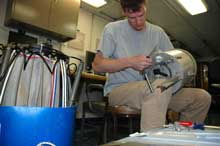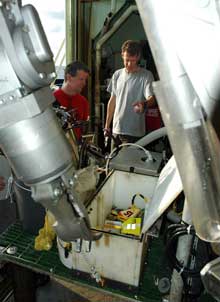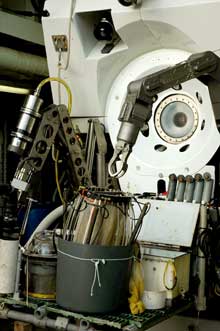
Senior research technician Guy Telesnicki works late into the evening, preparing science equipment for the next deep submergence vehicle (DSV) Alvin dive. The “Bushmaster Jr.,” a tubeworm community-collecting device is in the foreground. Guy is making final adjustments to a mussel pot. Click image for larger view and image credit.
During final preparations for the DSV Alvin dive, Chief Scientist Chuck Fisher and Guy Telesnicki discuss the placement of gear on the science basket. Click image for larger view and image credit.
Squeeze It In!
May 14, 2006
Guy Telesnicki
Senior Research Technician
Penn State University
28°07.64 N
089°08.47 W
The deep submergence vehicle (DSV) Alvin submersible has the ability to carry several pieces of highly specialized scientific gear to the ocean floor. On this cruise, our scientific arsenal consists of slurp guns, mussel pots, push cores, various cameras, in situ chemical probes, hydraulic tubeworm collectors, crab traps, a tubeworm staining device, scoop nets, and bioboxes. Typically, this equipment is attached to the science basket, which is a 4- by 3-ft grated platform attached to DSV Alvin’s bow. Not surprisingly, we have more equipment than basket space, and decisions need to be made regarding sampling priorities. Gear must be thoughtfully placed on the basket in order to maximize the scientific productivity of every minute of bottom time.
The configuration of gear on the front of the submersible is particularly important. The sub’s manipulator arms must be able to reach every piece of equipment. Moreover, the science gear must be kept as compact as possible to avoid getting entangled with the many cables and hydraulic lines that run along the front of the sub. Simply put, every inch of basket space is precious.
Consideration must be given to the order of deployment or use, as some items may be stacked on top of others. The buoyancy or weight in water must be calculated for each piece of equipment in order to determine how the gear will affect Alvin’s buoyancy. Equipment that will be left on the bottom and recovered at a later date must be designed in a way to make it easy to find. Brightly coated floats of incompressible material or electronic homing beacons may need to be attached to facilitate relocation.
Since the pressure at depth is much greater than at the sea surface, all equipment with air pockets or implodeable volumes must be pressure tested and certified to 150% of the planned dive depth. Any electronics that are to be used inside Alvin need to be tested for off-gassing and electronic and hydraulic equipment must be compatible with Alvin’s systems. All pressure and gas testing much be done several months before the cruise begins. The strict rules regarding pressure and gas testing are required in order to maintain Alvin’s stellar safety record.
On this particular cruise, we have a very diverse group of scientists, including geologists, geochemists, geophysicists, ecologists, physiologists, microbiologists, and molecular biologists. This allows a multi-disciplinary approach to research, but it also complicates sampling priorities. There are just too many types of gear and too little space to fit every piece of equipment on the front of the sub for every dive. The chief scientists have the difficult job of deciding which gear is placed on the sub for each dive. Fortunately, most of the gear provides samples or data that can be shared among the various groups. If everything goes as planned, the scientists’ cooperation and patience should pay off and there will be more than enough animals, mud, water, rocks, and pictures to keep all of the science crew working long into the night — and for years to come.
Sign up for the Ocean Explorer E-mail Update List.































